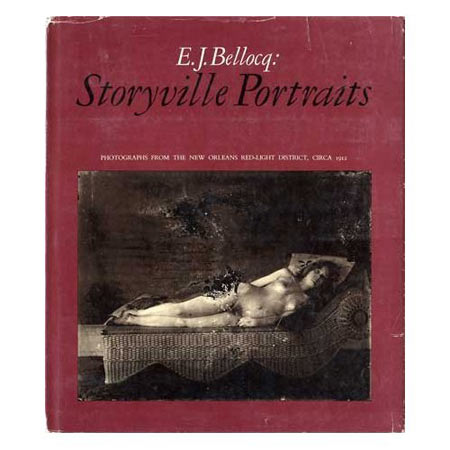Review: E.J. Bellocq: Storyville Portraits
 The background: New Orleans, ca. 1912, the red-light district called “Storyville”. The “hero”: E.J. Bellocq, a photographer there, whose active period extends into the 1940s. The other “hero”: Lee Friedlander, whose interest in jazz and in the city brings him to New Orleans, where through a collector named Larry Borenstein he first comes across the (re-printed) photographs and then the original glass plates of some of Bellocq’s work, found in a desk after his death. In 1966, Friedlander acquires the plates - by now, some of them heavily damaged by years of abuse by the elements, neglect and acts of censorship (some of the faces are scratched out). Through a bit of trial and error Friedlander manages to produce a full set of prints, eighty-nine of them, thirty-four of which (there are thirty-three numbered plates plus one image in the front) are reproduced in Storyville Portraits
The background: New Orleans, ca. 1912, the red-light district called “Storyville”. The “hero”: E.J. Bellocq, a photographer there, whose active period extends into the 1940s. The other “hero”: Lee Friedlander, whose interest in jazz and in the city brings him to New Orleans, where through a collector named Larry Borenstein he first comes across the (re-printed) photographs and then the original glass plates of some of Bellocq’s work, found in a desk after his death. In 1966, Friedlander acquires the plates - by now, some of them heavily damaged by years of abuse by the elements, neglect and acts of censorship (some of the faces are scratched out). Through a bit of trial and error Friedlander manages to produce a full set of prints, eighty-nine of them, thirty-four of which (there are thirty-three numbered plates plus one image in the front) are reproduced in Storyville Portraits, published by the Museum of Modern Art in 1970 (using an edit by John Szarkowski).
There exists an extended article on Bellocq, written by Nan Goldin. But as so often with these kinds of stories, knowing less makes for a vastly better experience. In the case of Storyville Portraits, some research (of course) was done, and it is contained in the book in the form of what looks like a long conversation between a bunch of people (in reality, this piece was compiled from four conversations plus excerpts from a letter):
“Lee [Friedlander]: The impression I’ve had is that nobody seems to really know Bellocq.
Johnny [Wiggs, a cornetist from New Orleans]: No, he was awful hard to get to know. And of course nobody was that interested in knowing him. I mean, there was a funny looking guy, you know, and he wasn’t interested in whether you were nice to him or not.”
He might have been a “hydrocephalic semi-dwarf” (Friedlander’s word in the book) or not (see Goldin’s article) - people love a good story, and why shouldn’t we? But regardless, what really matters are the photographs - portraits of Storyland prostitutes, some very formally posed (backdrops were being used), others maybe a bit less so (several of the women manage to hold a natural looking smile). Three of the women are holding and/or playing with dogs; many of them clearly are very much at ease with the photographer - whoever he was, Bellocq knew what he was doing: His photography reflects the tremendous respect and compassion he must have felt for his subjects. I’m using the word compassion not because the women were prostitutes, I’m using it because they were being treated as equals by the photographer - and not as subject matters.
If you haven’t seen the photographs you owe it to yourself to go to a library to look at the book - or to buy it. I found it at a local second-hand bookshop; this, of course, required a bit of luck (plus the existence of such shops, which are disappearing at an alarming rate in the US). There exists a newer version, expanded and with a foreword by Susan Sontag, but since there is nothing wrong with this book…